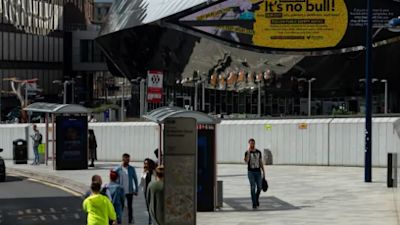What has lockdown 2.0 meant for Covid-19 infection rates in the Midlands?

There can be little doubt that Lockdown 2 has cut Covid-19 infection rates across the Midlands.
The debates over whether it was too soon or too late, too strict or not strict enough will continue. The argument over the economy versus public health will continue.
But if we judge solely on whether rates of transmission have been cut, then yes, lockdown worked.
It might not feel like that, especially if you live in a town which had no restrictions in October, only to emerge into the strictest Tier 3 restrictions this morning - and it might feel like the last month has been in vain.
But with only one or two exceptions, every district in the ITV Central region is in a much better place than it was a few weeks ago.
Reigning in the infection rates is rather like a 360 degree turn in an oil tanker. Act today, and you won’t see any effect on Covid numbers for at least two weeks - more likely three.
The hospital admissions won’t start to come down for at least a month. And death rates will continue to increase for at least six weeks or more.
In other words, it won’t feel like any great improvement straight away.
Think about it... If you caught Covid on the very last day before lockdown, it will have taken, on average, seven days for you to show symptoms. Sometimes as much as two weeks. Then you have to get a test and wait for the results ... that’s another couple of days.
And then if you live in a house with other people, lockdown doesn’t stop you from spreading it to them. It could take at least three weeks for your family members or housemates to catch it from you, develop symptoms and have the test.
So while some places today have the same rates, or even slightly more than when they went into lockdown on Guy Fawkes Night, the direction of travel - the momentum - is mostly heading down.
Take Stoke on Trent, which still has the highest Covid rate in the West Midlands. On the day Boris Johnson announced the new lockdown, Stoke had just recorded a rate of 372.1 weekly cases of Covid-19 for every 100,000 residents.
The rate continued to rise dramatically.
By 14 November, it had reached 570.3 weekly cases per 100,000 - a really concerning level of infection which was putting pressure on the hospital. But then, two weeks after the start of lockdown, the rate started to fall … and fall very rapidly.
The most recent figures we have put infection rates in Stoke at 364.7. Still way above the national average, still the highest rate in the region, and not far off what it was at the start of lockdown.
But where would Stoke be now without lockdown? It’s impossible to know for sure, but it is a reasonable assumption that rates would have continued to rise after the peak on 14 November and currently sit much higher than today’s rate which is comfortably under 400.
This story is repeated in hotspots around the Midlands to lesser or greater extents. In the Black Country, Birmingham, Derby, Leicester, Coventry.
Even in smaller places with much lower rates, the graphs have the same shape; a slow rise at the end of September which accelerates to a peak around mid-November and then a rapid fall.
Of course, this isn’t true everywhere.
Among the market towns and rural areas of Nottinghamshire the fall has been more steady, and started a little earlier … perhaps a reaction to the Tier Three restrictions introduced there in late October.
Areas with a high student population, like Charnwood in Leicestershire saw an earlier peak which coincided with the start of the University term. Instead of a rapid fall from the peak, the rate flatted as cases moved from the Loughborough University campus and into the general population. Then, the big fall came in mid November.
But there are places which defy explanation. The clear Covid hotspot in the ITV Central region at the moment is Boston in Lincolnshire. There were very few cases here through much of the Autumn, when the rate was well below the national average. But in early November, cases rose rapidly.
The borough seemed to be following the national trend in the middle of November as rates fell a little. But then a few days ago, came another sustained increase back over 500.
There are similar stories to tell in other parts of Lincolnshire.
But these are the exceptions. Nearly all other parts of the region have seen sustained falls in infection rates for two straight weeks. And with Covid’s in-built delay, we are likely to see that fall continue until the middle of December.
What happens to rates after that will depend on the success or failure of the Government’s new tiering system which comes into effect today.